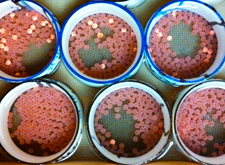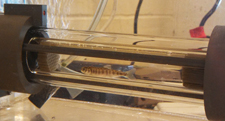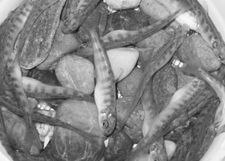Temperature influence on juvenile salmonid swimming performance
Summary:
Pacific salmon populations in California have rapidly declined in the past century, in large part due to dams and water diversions that block critical habitat and increase water temperatures in remaining habitat. Recent work shows that Pacific salmon exposed to high temperatures during incubation have decreased thermal tolerance later in life, impacting their health and survival. We tested the hypothesis that fish exposed to high temperatures early in development will exhibit reduced aerobic performance later in life. This project sheds light on the mechanistic underpinnings of salmonid declines in California, and provides valuable information to help inform management decisions and guide recovery plans.
Investigator:
Amanda Banet
Assistant Professor, Department of Biological Sciences
California State University, Chico
Project description:
Habitat degradation and climate change are introducing organisms to novel environmental conditions that they have not historically experienced. The ability of an organism to respond to these changes determines the persistence and health of the population in the future. In California, populations of Chinook salmon and Steelhead have dramatically declined over the past century, with the greatest decrease occurring since the construction of major dams and water diversions in 20th century. These dams have blocked critical habitat for salmonids, and have led to altered water characteristics in the remaining habit, including increases in water temperature. We know that increases in water temperature are tied to mortality and reduced reproductive success in these fish, but there is still much unknown about their capacity to deal with temperature stress on both an individual level and on a population level.
Some plasticity has been documented in salmon life histories, meaning that they can exhibit different characteristics depending on the environmental conditions that they experience. In some cases plasticity can be adaptive, allowing an organism to immediately respond to environmental conditions, unlike genetic changes that occur at the population level on a slower generational time scale. However, one recent study has indicated that while Pacific salmon do exhibit plasticity in response to high temperatures during egg incubation, this plasticity is maladaptive. Rather than inducing physical changes that increased their ability to function in high temperature environments, fish that were exposed to high temperatures early in development had lower thermal tolerances later in life. Another body of research has suggested that thermal tolerance is a function of an organism’s ability to successfully deliver oxygen to its cells.
Based on these studies, we can hypothesize that the aerobic capacity of an organism will be reduced in fish that were exposed to high incubation temperatures, and that this difference will be magnified if the fish is swimming in high temperature waters. Reduced aerobic performance can be harmful to an organism because it reduces the amount of energy an organism can devote to activities related to survival and reproduction, such as foraging, growth, migration, and escaping from predators.
The research tested two hypotheses by examining the swimming metabolism of Pacific salmonids that have been incubated at a range of temperatures. First we tested whether fish incubated at high temperatures have a lower aerobic scope than those incubated at low temperatures, and whether increasing water temperature during aerobic swimming more negatively affects the aerobic performance of fish incubated at high temperatures, as compared to fish incubated at low temperatures. This project provides insight into the mechanistic underpinnings of salmonid declines in California, and provides valuable information that can be used to help inform management decisions and guide recovery plans.



All photos courtesy of A. Banet.
